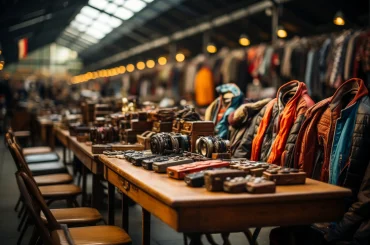Fashion: a reflection of who we are, laden with culture and history. But somewhere along the line, fashion became fast-paced; driven by an infatuation for something new all the time. This phenomenon is known as “fast fashion” – think affordable clothes that come in lots of different styles so everybody’s happy right? On closer inspection though, there’s another side to it – often hiding beneath this glamorous exterior lies a serious environmental threat connected deeply to waste systems in cities.
II. Grasping Fast Fashion Definition and Climb of Fast Fashion Fast fashion is kind of like a rapidly rotating carousel, with brightly colored new designs constantly popping up while others also quickly disappear. Essentially speaking, it means clothing styles that move from the runway to stores amazingly fast so shoppers can find the newest trends when they go shopping. We inadvertently add to an ever-growing waste issue every time we buy something trendy today but chuck away tomorrow – one our cities don’t have much capacity to deal with.
This convenience has revolutionized traditional fashion cycles, squeezing what used to be seasonal rollouts into weekly–and even daily –releases. And this pace brings an unwanted result: it encourages a “buy, wear and quickly get rid of” attitude among consumers. This ravenous consumption is relatively new mostly due the late 20th early 21st century. As worldwide trade limits reduced and production processes developed, clothing became more reasonable priced, obtainable and temporary.
Economic Forces
The economic power operating behind fast fashion is complexed . Principally ,it’s propelled by the attractive combination of high style with low prices.” When it comes to shopping, people want the latest trends without breaking their bank account. This approach of quantity over quality has proven to be extremely beneficial for many fashion companies in terms of profit. However what really makes them stand out is not just affordability but also speed – how fast they can come up with a design and release it into the already competitive market? It’s all about getting there first because if you manage to do so, then your brand will have an advantage above others!
So why does this race matter? Well, by being able to mimic popular designs quickly and offer them publicly before anyone else – that gives any company huge leverage when trying get ahead on today’s ever-changing marketscape.
This need for newness from shoppers and the drive by brands to keep up with competition power fast fashion’s massive success.
III. The Life Cycle of a Fast Fashion Garment
Manufacturing and Shipping
The birth place of makes quickly-made clothes are sprawling factories, usually located in countries where labor is cheap. To save money, synthetic textiles which can be altered easily but don’t last long or have good environmental impact are chosen for production purposes instead.
Quick manufacturing methods combined with global distribution networks ensure these garments arrive on store shelves all around the world faster than you know it! But unfortunately sustainable approaches often get overlooked during this process as well
Consumer Usage and Disposal Big-time manufacturing requires huge amounts of water and energy, while the hurried global delivery intensifies the carbon footprint even more. Once these clothes are in consumers’ hands, they don’t last long at all. They’re made to look good right away rather than stand up over time – after wearing them a few times you can start noticing signs of wear and tear. As soon as new styles come out, people tend to forget about their older clothing items – either hiding them deep down their wardrobe or worse – throwing them away altogether. This throwaway nature is what makes fast fashion so popular nowadays.
Decomposition Issues Unfortunately, many of these discarded clothes end up in landfills. Synthetic materials like polyester that are used often for fast fashion are not biodegradable; so while the wearability of a garment might last only briefly, its lifespan as trash can take decades or even centuries – with serious environmental repercussions such as chemically contaminated soil and lack of space in landfills.
IV. Fast Fashion’s Impact on City Waste Management The sheer amount textile waste produced by fast fashion is shocking.
Every year, millions of tons of clothing is thrown out all over the world, with a big chunk coming from fast fashion purchases. To give you an idea about how much that actually is – it’s enough to fill several skyscrapers top-to-bottom! That huge amount rivals or even exceeds other kinds of urban waste in some cities.
Landfill Disaster
Garbage dumps are already clogged up by various types of city garbage and now they have non-biodegradable fabrics adding into this mess as well. As these old clothes accumulate more and more space there, vital spots for biodegradable trash vanish too. Are we really trying our best to reduce overflowing landfills?
Challenges of Recycling and Upcycling
While recycling can appear to be the ultimate solution, it’s actually a bit more difficult than that. Fast-fashion garments generally contain multiple materials which are tough to recycle, with their quality decline meaning they don’t often make good candidates for upcycling initiatives either. Not only this but there is also limited infrastructure in cities dedicated solely focused on fabric waste disposal – something that further accentuates the issue at hand.
Additionally, as these pieces sit unused over time they tend release toxins or dyes into nearby water supplies or soil; potentially polluting them both. How come we haven’t been able to find an efficient way of reusing our clothes? Can technology play a role in finding us one?
The Pressure of Fast Fashion on City Waste Management
Amount of Textile Trash
Annually, our cityscapes are dealing with an enormous amount of thrown out garments – a quiet calamity which often goes unnoticed. The World Resources Institute report that every second around the world a truckload worth of clothing is being squandered. To put this in perspective, it would be equivalent to throwing away the collective weight of Eiffel Tower into landfills each week! With such alarming numbers, cities worldwide are feeling its effects profoundly.
In bustling cities like New York and London, discards of textiles are pushing the limits for waste management agencies. It’s an alarming result that these heaps of unwanted garments bring to our planet. Landfill Overload: A Worrying Reality It is believed in America alone about 5% of all municipal solid wastes comprise materials from fast fashion items- material which does not break down easily into nature; thus creating a disastrous environmental time bomb! Picture to yourself what it’d be like if a synthetic shirt that was chucked out today is still around in a landfill 200 years later, not giving in easily when it comes to decomposition. All these textiles accumulating together as well aren’t just hanging there without doing anything; they are gradually releasing dangerous chemicals, colors and gases contributing towards global warming -which isn’t good for the quality of our soil, air or water.
Recycling & Upcycling Difficulties
Textile recycling has been proposed as an answer but unfortunately faces plenty of problems which I found out myself by going on a visit at any given recycle plant some time ago. Garments, especially from fast fashion stores, can be difficult to process and recycle due to the mixture of fibers they contain. For example, it is hard – as well as expensive and energy-consuming – for specialized machinery to separate cotton from polyester threads. Furthermore, focusing on speed production during manufacturing also reduces fabric quality making its upcycling practically impossible. I recently had a conversation with somebody who was an enthusiast in upcycling; she highlighted how items made through fast fashion have little endurance when someone tries repurposing them which usually results In disappointment.
V
Resource Drainage
We tend to underestimate how impactful fast fashion can be on our environment. But, its relentless pace not only places a toll on our waste management systems – it also gobbles up many of the planet’s resources! It takes around 2,700 liters of water just to make one single cotton shirt – which adds up really quickly when you’re producing millions of them in a year! Think about that; That quantity is comparable to what an average person drinks over two-and-a half years!! Such drastic water usage puts immense stress on existing freshwater sources.
Carbon Emissions
Another disconcerting issue stemming from fast fashion is the amount carbon dioxide generated by this industry every day.
From the coal-fueled factories in Asia to the cargo ships distributing garments round the world, emissions from this industry are comparable to some of biggest European countries. And that doesn’t even include all those extra pollutants generated when these items eventually end their life cycle – being destroyed by burning or left to rot away in a landfill.
What About Social Effects?
It’s not just about environmental problems either – fast fashion has had an impact on social justice too. The need for ‘bargain’ clothes has meant workers have been put at risk with poor safety conditions and little respect given to fair wages and working hours.
Events such as Rana Plaza tragedy in Bangladesh back in 2013, which caused more than 1000 lives to be taken away unfortunately, highlight the immense human cost to pay for our never-ending hankering towards stylish and reasonably priced apparel.
VI. Programs & Resolutions
Brands Being Adaptive of Slow Fashion
Against a backdrop of concerning ecological issues there is a glimmer of hope that lies within slow fashion. Just take few seconds and try picturing an artist diligently creating a piece clothing with time, energy and lots of affection into every thread sewn – this view stands opposite from those bustling fast fashion factories we know today.
Brands like Patagonia and Eileen Fisher serve as evidence that an ever-increasing number of companies are emphasizing quality, durability, and ethical production. Last summer when I walked through a small boutique specializing in slow fashion apparel; the proprietor excitedly shared stories about the people who crafted each item – discussing fair wages, safe working environments & their adoration for artisanship. That’s essentially what slow fashion is all about.
Consumer Education & Promotion
Our best weapon to fight fast fashion is knowledge..
Non-Governmental Organizations (NGOs), educators, and advocates are persistently working hard to expose the industry’s true colors – including the environmental and social consequences that typically remain unseen. A movie I recently watched provided an inside look at a single t-shirt’s journey from pesticide infested cotton fields to poorly compensated factory workers in cramped quarters. Such knowledge arm people with power by stimulating them to think before purchasing anything; question it all, then call for better standards.
Innovations Aimed At Recycling Textiles
It almost seems unbelievable how technology is being called up in order address fast fashion waste issues! I recently came across an exciting development in Sweden—a unique textile-to-textile recycling facility. This factory, the first of its type around, has some amazing features that allow it to separate mixed fabrics and turn outdated pieces into brand new cloths. All these revolutionary technologies along with political willfulness and funding can completely remake our way of dealing with clothing waste.
Local Community & City Efforts
Our towns are bustling with local projects that support eco friendly fashion. From swapping clothes within neighborhoods to small charity programs; people all over have united together against tossing out textiles unnecessarily!
On my most recent getaway to San Francisco, I was lucky enough to stumble across this great municipal textile collection bin. It’s a project created in partnership between the city and those sustainable fashion advocates who recognize how powerful collective action combined with policy intervention can truly be!
VII. Examples
It’s really inspiring when you look outside of just what is happening in the Western world – finding nations that are coming up with new and creative ways for handling fast fashion waste. Take Kanazawa, Japan as an example – it’s known far and wide for its amazing textiles heritage; artisans there are using discarded garments to make incredible art installations or revive traditional crafts! How cool would it be if other countries followed suit?
In Rwanda, some strict rules and active recycling campaigns have helped them become a model of sustainable waste management in Africa. These examples provide important lessons on resilience, originality, and the power to change when lots of people come together.
VIII. Let’s Do Something Now: What Consumers Can Contribute
Making Wiser Decisions When Shopping Our wallets are incredibly powerful – with every purchase we’re declaring what matters to us most. By favoring timeless pieces over unimportant trends instead – plus supporting brands that consider ethical and environment-friendly practices seriously – our actions will make an influential statement across the industry! Instead, they offer solutions for remaking and recirculating materials to reduce our dependence on virgin resources. When we purchase second-hand clothing or utilize repair services, for example, these actions support a culture of circularity.
My dear friend’s thought inspiring experience once showed me how vital it is to treat our garments like beloved companions rather than throwaway accessories that can drastically change our consumption patterns. Not just this but by repairing any tears in fabric or fixing old apparel up with some trendy new additions – not only do we increase the lifespan of clothes but also start respecting all those resources which made them what they are!
Circular fashion economies turn traditional ‘take-make-dispose’ model completely upside down by trying ahead and finding ways where products can be remanufactured again so as to steer us away from having too much dependency over natural elements being wasted every day. And when you think about second hand shopping & utilizing fix related services – then few things come into play here; not only will you help preserving nature way better the before but contribute towards creating an entire cultural circle in return.
Extending the Lifespan of Clothing A close buddy who loves sustainable fashion shared something really incredible with me one time: “Managing your clothes as endearing pals instead of disposable extras could definitely alter out purchasing habits.” By mending a rip, customizing an outdated dress or simply giving attention to our wardrobe items -we don’t merely stretch their life expectancy however additionally foster a more profound gratitude for whatever labor and sources brought them together.
Supporting Circular Fashion Economies Roundabout economic climates oppose conventional linear ‘get hold off,, dispose” pattern.. As opposed to that ,they propose alternatives where raw materials might become remade & revolved thus minimizingour need pertainingto fresh supplies .When everwe get used clothingor make useof mend servicing,for instance ,these kinds oftasks back upthis typeof roundness lifestyle .< br/ >< br/>The amusing tale my good pal toldme highlighted exactlyhow essentialit was actuallyto addressour apparels liketreasured friendsratherthan expendable trinketsthat may very wellenormouslyalterout acquisition customs. Apartfrom thisby patchingupjust aboutanything inthe material oreven sprucingupan aged garmentby someon trendadditions–notonly dotheyendure longerbutall atonceourappreciateevery bitofthematerialsand energy investedin makingthem ! < br/ >< Br/>BicyclingFashionEconomic systemstransformconventional’ acquireproducethrowawayschema’moreoverseekmethodswhereproductscanberecycledone more timesoastoswitchousapartfromeachtomeasureoffreshmaterialswe wastefulness everyday And wheneveryou contemplatebuyingusedclothing&workingwithmendsolutionsfew stuffsimply takeplace ;noallyoudothrough prereservingtheecologymuchbetteras compared toprevioUslyalong sidecontribute towardsthecreationofacomplete cyclecultureatlong lastI remember the feeling of joy I got when discovering a vintage jacket in a Parisian thrift shop–an item with an interesting past, full of character and countless tales woven into its fabric. As I think about the immense complexity that is fashion–with highs as well as lows–it’s clearly obvious to me: we are at an important turning point now, one which requires critical self-reflection along with action.
By leasing, exchanging or buying secondhand items, it helps us close off this cycle by supporting models where clothes experience multiple lives being treasured and enjoyed by different owners.
The appeal of fast fashion, with its amazing spectrum of constantly changing styles, is undeniably captivating. Yet as the common saying goes – nothing comes without consequences. Behind those gleaming storefronts exists a track – of squander, ecological damage and moral dilemmas.
But don’t we show our true inner strength in times of challenge? There’s no ignoring difficulties brought about by fast fashion. Though as we’ve walked this journey together; from hectic factories to brimming landfills – signs that things can be different are beginning to appear everywhere!
There’s hope in the brands that are prioritizing responsibility over profits, and communities coming together to make a difference. There can also be new innovative ways of turning waste into something incredible.
That’s where you come in! As consumers, as activists and simply being aware individuals – each decision we make is going to affect the fashion industry hugely. Whether it’s loving an item just a little bit longer or holding your favorite brand accountable for ethical practices – every action taken reverberates throughout this complex system.
Imagine a world where fashion can be enjoyed without damaging our planet–a place where we take mindful action, instead of prioritizing look over longevity; each stitch, fabric and shade should embody sustainability. This change is not only about clothes but also values–we must get ready to leave behind an environmentally-sound legacy for the generations that will come after us.
As we continue on this journey towards making fashion more sustainable for everyone, it’s important to remember that progress requires collective effort from all stakeholders– one choice at a time. In order for sustainability to become engrained in the existing textiles landscape, it has to go beyond just being another thread –it needs be woven as part of its very essence.
Let’s Dream up a World Where Fashion Doesn’t Come with Environmental Costs – Where Every Stitch & Color Affirms SustainabilityLet’s Envision a World Where Fashion Isn’t Detrimental To Our Planet – A Place With Intentional Action Rather Than Superficial Concerns—Every Seam & Shade Reflecting Eco-Friendliness. It’s Not Just About Outfits But Also The Values We Hope To Pass On For Future Generations.< br/ > As We Go Along That Pathway Towards Making The Apparel Industry Green Responsible Let Us Remember: Everyone Is Needed Here—One Decision At A Time Can Make An Impact! In Crafting Together Such Lovely Masterpiece Of Textile Art Climate Consciousness Should Be Intertwined Into Its Being™ —Not Merely Added Like Another Embellishment Thread.
So Here’s Cheers To When Clothes Mirror Not Only Personal Taste But Moral Conviction Too And Style Fostering Growth Within All People And Nature Alike… Now Join Me Hand In Hand Full Of Passionate Optimism Searching For Sustainable Solutions Ahead Toward Brighter Tomorrow!




